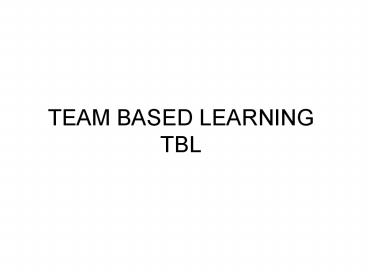TEAM BASED LEARNING TBL - PowerPoint PPT Presentation
1 / 22
Title:
TEAM BASED LEARNING TBL
Description:
Some concerned about being disagreeable or overly aggressive. Task may be completed by one or two members working alone. Task does not require member agreement ... – PowerPoint PPT presentation
Number of Views:759
Avg rating:3.0/5.0
Title: TEAM BASED LEARNING TBL
1
TEAM BASED LEARNING TBL
2
WHAT IS TBL
- Strategy for learning content
- Strategy for content application
3
WHY TBL
- Enhance student learning
- Promote student involvement
- Foster team building
4
Essential Principles of TBL
- Teams must be properly formed and managed
- Students must be made accountable
- Team assignments must promote both learning and
team development - Students must receive frequent and immediate
feedback
5
FORMING TEAMS (GROUPS)
- Minimize barriers to cohesiveness
- Distribute member resources
- Within Diverse
- Between Evenly matched
- Permanent
- Fairly large (5-7 members)
- Formed by instructor
6
Sequence of Learning ActivitiesOut of class
In class
- Reading RAP process
- Homework Group work
- Homework Group work
- Review Group project/exam
- Four to seven learning modules per semester
7
RAP Process
- Individual Readiness Assessment Test (RAT)
Usually true-false or multiple choice covering
content - Team Test (RAT) Same as individual
- Appeals
- Corrective instruction
8
STUDENTS MUST BE ACCOUNTABLE
- For individual pre-class preparation
- For high-quality team performance
- For contributing to their team
9
Grading Components
- Individual performance
- RAT
- Individual exams or papers
- Group performance
- RAT
- Projects or activities or exams
- Peer evaluation
10
Assignments promote learning and team development
- Overcome forces that promote social loafing
(uneven member participation) - Make assignments to promote group cohesiveness
- Key variables
- Avoid assignments that reduce cohesiveness
11
Social Loafing Forces
- Some resist participation
- Some prefer to dominate
- Some believe they lack content knowledge
- Some may not be committed to group success
- Some concerned about being disagreeable or overly
aggressive - Task may be completed by one or two members
working alone - Task does not require member agreement
12
Promote Group CohesivenessAssignment Key
Variables
- High level of individual accountability
- Bring members into close proximity
- Motivate discussion among team members
- Insure immediate, unambiguous and meaningful
feedback - Provide explicit rewards for team performance
13
Individual Accountability
- Advance preparation (RAT individual)
- Each member contributes (RAT group)
- These promote learning and
- Bring shy students into discussion
- Tones down dominant members they start to listen
14
Proximity of members
- Use in class assignments
- Avoid assignments that can be completed outside
of class by members working individually - Promotes team development
15
Motivate Discussion
- Make assignments that require a concrete decision
that is based on analysis of a complex issue - The shorter the answer the better
- Promotes content learning
- Reinforces aspects of group interaction
- Other members input is important
- Accomplish more working together than each can on
their own
16
Provide Meaningful Feedback
- Powerful
- Compare to other groups
- Motivates groups to be the best
- Must defend groups choice against challenges
- The more immediate the feedback the better
17
Reward Group Success
- Must count for the grade
- Love of learning is generally not a sufficient
motivator - Without reward for group success, members see
themselves as only competing with other members
18
Feedback
- The quicker the better
- Other group members
- Other groups
- Instructor
19
Effective Group Activities
- Employ the 3 S approach
- Same assignment
- Specific choice
- Simultaneous reporting
20
Effective Group Activities
- Prior to group discussion
- Are group members working on the same assignment
and required to make a specific choice,
individually and in writing?
21
Effective Group Activities
- During discussions within groups
- Are groups required to share members individual
choices and agree on a specific choice? - Will the discussion focus on Why/How
- Will the groups choice(s) be represented in a
form that enables immediate and direct
comparisons with other groups?
22
Effective Group Activities
- During discussions between groups
- Are group decisions reported simultaneously?
- Do group reports focus attention on absolutely
key issues? - Are groups given the opportunity to digest and
reflect on the entire set of reports before
total class discussion begins? - Will the discussion focus on Why/How?































